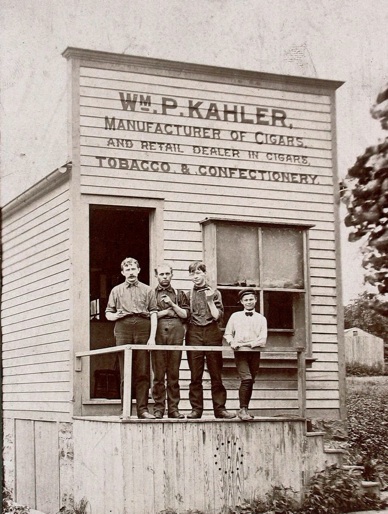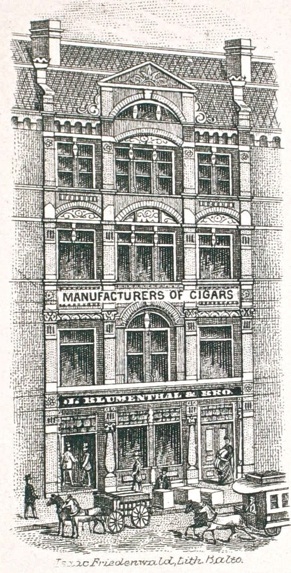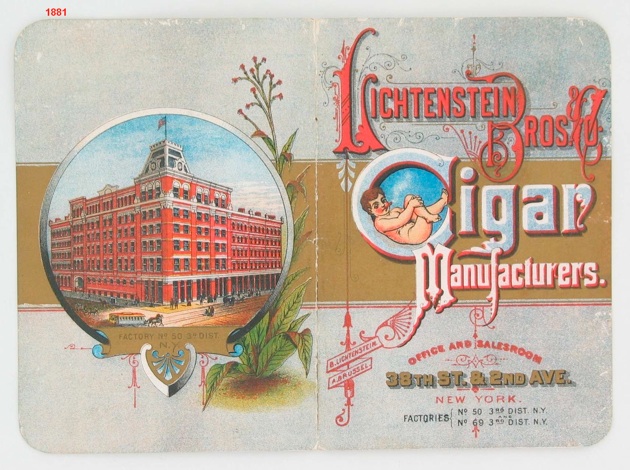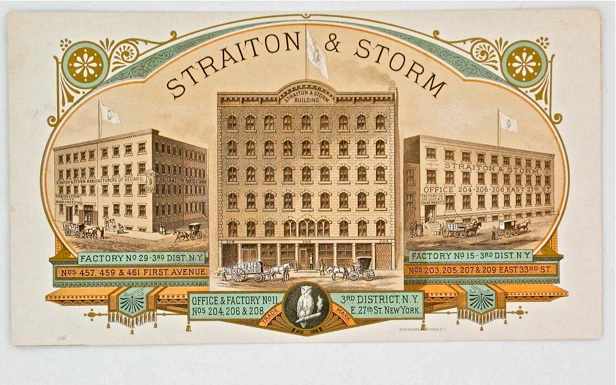
CIGAR FACTORIES IN 1885
Where They Were; What They Looked Like
A National Cigar History Museum Exclusive
© Tony Hyman
Modified: June 24, 2010
This Exhibit is not intended to be a history of the cigar industry, it’s factories or their production. The purpose of this Exhibit is more modest. It is to give you a state-by-state overview of cigar factories in operation in 1885, an important transitional period. That year, every State and Territory had at least one cigar factory, but looking at every speck of U.S. geography is not a fruitful use of my or your limited time. I have chosen instead to focus on the 20 states with the most factories. State-by-state you will see how many small, medium and large factories each state had, and where key ones were located.
At the end of each state’s summary, I have identified the large factories in operation there, including (1) the Name of the Company or it’s registered owner, (2) it’s street address (available only in large cities), (3) the city in which it is located, (4) the number of rollers the factory was Federally bonded to employ [in brackets] and (5) the Federally assigned I.D. which consists of the Factory Number and tax District, required to be imprinted on every box of cigars. The entries for Pennsylvania, New York and a few other states, give a brief look at that state’s “cigar towns.”
Ladies and gentlemen, I give you another Cigar History Museum Exclusive: Cigar Factories in 1885, as compiled in Directory of the Tobacco Industry of the United States and Havana, Cuba. Exhibit annotated by Tony Hyman.
Survey-takers did generally agree that a large cigar factory was one employing 100 or more rollers. Factories that size are capable of making 25,000 cigars a day, another quantity that helps define a large factory.
In 1885, there were 24 cigar factories in the United States that employed 500 or more rollers; three of those establishments had 1,000 rollers, giving them an output of a quarter million cigars a day, more than 50,000,000 cigars a year. Giant factories tended to make their own brands as well as offer private labels to wholesalers, jobbers, retailers, anyone who wanted them. Straiton & Storm (below) is perhaps most famous for creating OWL and ROBT. BURNS, but it’s 1,000 rollers filled boxes for hundreds of brands offered nationwide. Boxes with an ID reading Fact. 11, 3rd Dist. NY are Straiton & Storm brands.
Also below is a price list depicting the Factory of Lichtenstein Bros., another of the factory giants with 750 rollers in 1885. They too made hundreds of brands. Boxes marked as coming from Fact. 50, 3rd Dist. NY are Lichtenstein creations.
Museum visitors are frequently shocked when I tell them the United States was home to a quarter million cigar factories and produced approximately 2,000,000 different brands of cigar, more factories and more brands than any other branded product in history. In this exhibit, you will learn where those figures came from.
The year 1885 is the perfect choice to begin the Cigar History Museum’s series of exhibits about cigar factories. The Golden Age of the America Cigar had begun only five years earlier. It’s an important time in the industry...a very good time.
In the late 1870s new high quality domestic cigar tobaccos had come to market and Sumatran wrapper, the world’s best, began to be imported. As if that weren’t enough, in 1878, the IRS loosed what had been highly constrictive regulations defining what cigar boxes should look like, thus opening the way for inventive and appealing novelty packaging. Not only were fancier boxes and better tobacco available, but Civil war tobacco taxes had been substantially reduced in 1883, which meant the new higher quality cigars cost less. Cigar smoking caught on with men of all classes. The number of cigar factories rose dramatically.



In this exhibit, cigar factories are divided into three categories based on the number of rollers: small (less than 10 rollers), medium (10 to 99 rollers) and large (100 or more rollers). This classi-fication was not chosen at random. Over the years, the criterion for what was considered a small, medium or large factory varied by who was doing the counting and why. The federal government, the state governments, the labor department, trade groups, the census, the IRS, the Cigar Maker’s Union and others were never in complete agreement. A small factory, for example, at various times was defined as having three workers, fewer than five
rollers or fewer than 10. I’ve chosen to use the latter criterion so as to be in accord with the only available Tobacco Industry Directory that published the number of rollers permitted in each factory.

Medium size factories, defined as those with 10 to 99 rollers, were located in cities, towns and open countryside. In the city, factories with 30 or more rollers tended to locate in multistory buildings so the various processes could be performed separately.
Typically, the ground floor was for tobacco storage, sweating and blending. The second floor was for manufacture and the top floor was used for packing and shipping. Mid size factories located in cities, like that at left, often operated a retail store to catch walk in trade. Mid-size factories in small towns or in the countryside often made cigars exclusively for the wholesale trade; railroads made it possible for a mid-size company to make 100 or more brands for various wholesalers in a half dozen or more states.
Small factories were almost always all male or employed female family members; medium size factories were frequently all
female.




Before you begin...
If you are one of those people who enjoys taking tests... seeing how much you know... Here’s your chance.
These are the 20 states with the most factories.
Part II of this exhibit has them in order
from most to least.
CAN YOU PUT THEM IN ORDER?
[A] California, [B] Connecticut, [C] Florida, [D] Illinois,
[E] Indiana, [F] Iowa, [G] Kansas, [H] Kentucky,
[K] Louisiana, [M] Maryland, [N] Massachusetts,
[O] Michigan, [P] Minnesota, [R] Missouri,
[S] New Jersey, [T] New York, [V] Ohio,
[W] Pennsylvania, [X] Virginia, [Z] Wisconsin,